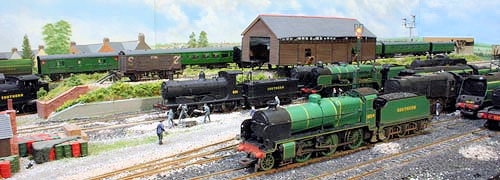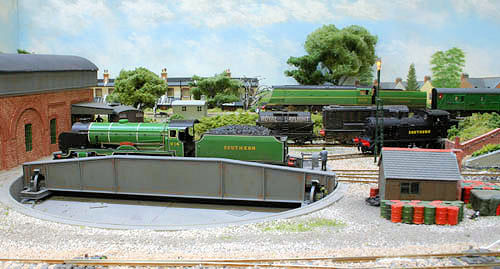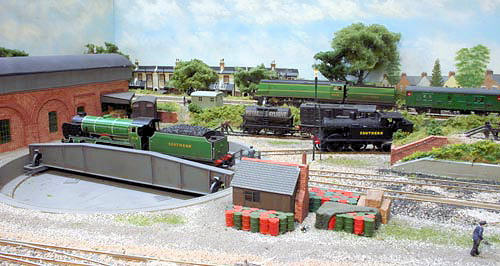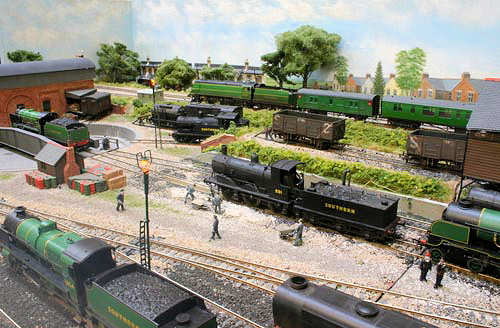Fisherton Sarum - Southern Railway MPD 1946-49
by Graham "Muz" Muspratt
| The purpose of this layout/diorama was an interim measure to provide a showcase for some of my rolling stock, as I was not in a position due to space constraints to build either of the two other layouts that I have ambitions for. |
 A view towards the coal stage, 21C121's train of Bulleid 1946 built coaches (from Phoenix kits) is still passing. Locomotive classes on shed include N, N1, 700, LN, Q1, D15, Merchant Navy, Battle of Britain and K. |
| Having looked at the plans for various Southern sheds such as
Salisbury and Bricklayers Arms it was soon realised that a compromise was
needed. In the end I used Salisbury as the inspiration for the layout (as it
has a family connection) and the basis for the structures on the layout. The name originates from the fact I wanted to retain the link to Salisbury without actually calling it Salisbury. The current station at Salisbury, to differentiate it from Salisbury Milford (later closed to passengers and kept solely for goods traffic) was originally called Salisbury Fisherton as it is located on Fisherton Street, with the original pre-1901 shed called Fisherton shed. Old Sarum, of course, is the famous hill fort and Roman centre forming part of the origins of Salisbury. The key elements taken from Salisbury were as follows:
Locomotives arrive and depart to and from the station to the east (i.e. the fiddle yard). Some locos can then be seen on trains heading to the west country, likewise locomotives on trains from the west then appear on shed for coaling etc. Most represent locomotives seen at Salisbury although occasional other visitors arrive, my excuse is that they have arrived from Eastleigh on a running-in turn after a works visit. I have tried to create a number of cameo scenes around the layout these include: gangers taking a break by the PW hut (one of whom is a representation of my Grandfather who actually worked at Salisbury as a Ganger), workers filling wheelbarrows with ash, loco cleaners on duty with ladders, various loco crew awaiting their next duty, maintenance staff in and around the shed, a wheeltapper walking along side the carriage siding, a gardener tending his back garden, the postman about to receive attention from the household's dog that has got between him and his bike and a group of school children trying to sneak access in to the shed (one of whom represents my Dad during his short trousers days!) Other details include: two types of LSWR water columns as seen at Salisbury (scratch built from brass tube and rod) and braziers, working yard lamps, various yard cats, piles of ash and working LSWR style signals on the main line. Basic scenery is formed from Mod Roc with a plaster coating (mixed with
brown powder paint to ensure if chipped white patches do not show) for the
embankment sides and to form the basic road surface at the west end of the
boards. Various Woodland Scenics ® and other scatter materials are then
used to build up the ground cover. The signals on the main lines, built from Model Signal Engineering (MSE) components, represent the up station approach bracket signal (with fixed distants) and down advance starter and are operated by MSE actuators. The original LSWR style Lattice upper quadrant signals at Salisbury were pneumatically operated hence the small cylinder located on the dolly just beneath the arm. I must extend a big thank you to fellow High Wycombe and District Model Railway Society member Ron North for his excellent hand painted backscene. |
 |
Schools classNº914 Eastbourne (Hornby model fitted with correct large diameter chimney) is turned whilst O2 classNº213 waits.Nº21C121, yet to be named Dartmoor, (Hornby early light pacific, with Crownline detailing kit, scratch built original style flat fronted cab, short smoke deflectors and an etched brass tender) accelerates away towards the West England. VanNº12 behind 21C121 is one of the safe fitted vans modified from a Parkside BY kit. |
| Another view of the turntable, as per the above photo. |  |
 |
Different angle view as per the above but one photo. |
All photographs are copyright Graham "Muz" Muspratt
This page was created 29 December 2007